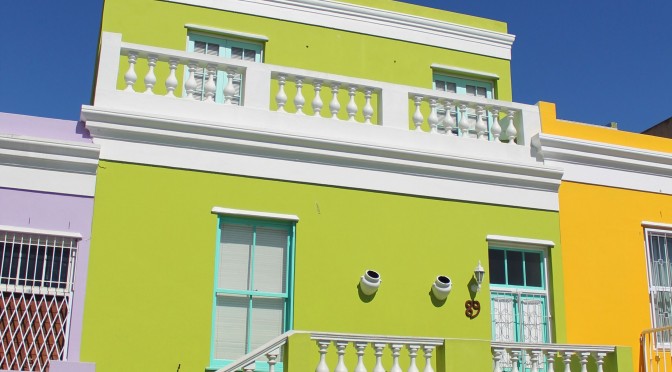I finally got to visit the Bo-Kaap area of Cape Town recently. Widely known for its colourfully painted houses, it sits on the slopes of Signal Hill and embodies an interesting part of the Cape’s history. Walking through the cobbled streets one is enveloped in its rich cultural history.
Initially known as the Malay Quarter, it’s an historical centre of the Cape Malay culture. During the 16th and 17th centuries slaves from other parts of Africa, Indonesia, Java Malaysia, and Asia were imported into the Cape to fill artisanal roles for the affluent inhabitants.
This diverse group (they were not all of Malay descent) became known as the Cape Malays. This area, one of the oldest suburbs in Cape Town, is a well-known tourist attraction.
What struck me though, is that it is a living museum. Behind the beautiful facades are real homes inhabited by families. The identity of the area has been preserved despite the encroaching city centre and the commercialisation of the area. After 1994 these houses became very sought after as investment property for overseas investors and trendy Capetonians.
(click on any photo of the gallery to see the full-sized photos)
Gallery: Start your tour at the Bo-Kaap Museum on Wale Street. The museum tells the story of the area and its peoples. Walking tours of the area start here.
Gallery: Marvel at the beautiful and colourfully painted houses as you walk up and down the steep cobbled streets.
Rose’s Cafe has been in the area since the early days. At one time it was the only shop in the area to buy foodstuffs. It is still owned by the original family. Situated directly across from the Bo-Kaap Museum it makes a roaring trade from the tourists. It’s a haven of Malay food, ice-creams and cool-drinks, and still sells foodstuffs to the people who live there.

Bismillah’s Restaurant and Coffee Shop has also been in the area for many years, serving delicious Malay cuisine. Che and I had a date with Table Mountain otherwise we would have stopped in for lunch.

Gallery: The “living museum” – with these photos I want to show that it is an area where families live, children go to school and friends go for a walk whilst enjoying ice-cream. Descendants of the original families still live there.
There are many mosques in the area and during the day the call to prayer for the area’s muslims is heard throughout the area. This is the Auwal Mosque in Dorp Street. It was established in 1794 and is the oldest mosque in South Africa.

Gallery: Then there are those streets that are off the beaten track. I doubt whether many tourists make their way down these streets and alleys, but they are just as important as the beautiful houses on the main roads. They have beautiful views of the Table Mountain cable-way.
My favourite photo of the whole experience – matching house, matching car.

Entered in this week’s WordPress weekly photo challenge – theme is Enveloped. Click on the link to see more interpretations of this theme.
Discover more from Wide Eyed In Wonder
Subscribe to get the latest posts sent to your email.






















Thank you Regina for these beautiful photographs, what the photos do is highlight the positive side of life amidst the bad things that seem to feature on our television screens. Yes there may be xenophobia feelings in some quarters of the nation that should not colour the beautiful and positive things about life in South Africa. I am currently at home on holiday in Zimbabwe the state of the nation is dire to say the least,but there are very positive things going on in my beloved country. I will try to follow your example and highlight the good and positive things about my country.
Mabel Rudo Nyazika recently posted…Indecision
Amidst the things that aren’t good, there are always somethings that are good. In both your country and mine, it is the people, the everyday people, who give it soul. It is still on my plans to visit Zimbabwe. All that I have seen, in photos of friends who have visited it, and TV programs, it is a very beautiful country and one that I still want to visit. Enjoy your holiday 🙂